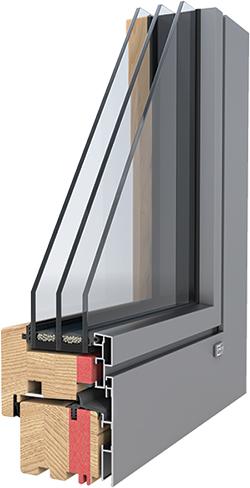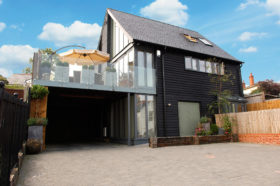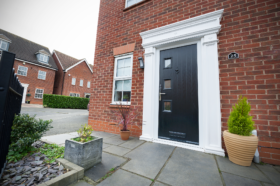
Learn from the experts with our online training course!
Use the code BUILD for 20% off
Learn from the experts with our online training course!
Use the code BUILD for 20% offDouble glazing (DG) works on the principle of trapping air in the gap between two panes of glass, thereby improving insulation and keeping useful warmth inside your home.
Triple glazed (3G) units take this a stage further, introducing a third pane (and second air gap) that gives an extra layer of thermal protection.
Both types can be upgraded to make them even more efficient, for instance by filling the air gap with an inert gas (such as argon), incorporating warm edge spacer bars or applying special coatings to the glass during manufacture.
The headline benefit of installing triple glazed windows is that they can make a big contribution to a well-insulated home with reduced heating bills.
Top-end versions can achieve whole-window U-values (a measure of heat loss, where lower numbers indicate better energy performance) down to 0.6 W/m2K. In comparison, the best double-glazed units will hit around 1.1 W/m2K to 1.3 W/m2K.
| Windows make or break your project, so getting them right is absolutely key. To start with, you need to decide between traditional timber, aluminium, uPVC, aluminium-clad timber and modern timber alternatives. Then should they be double or triple glazed? All these options will be on display at Build It Live, along with the experts who can share their knowledge about the benefits. Explore all the options in one place – only at Build It Live.
Watch live presentations on a variety of topics, such as:
Build It Live takes place three times a year in Kent, Oxfordshire and Exeter. The next show will be on 22nd and 23rd February 2025 in Maidstone, Kent. Claim a pair of free tickets today and start planning your visit. |
Getting great results isn’t just about improving the glazing spec; a good 3G window will include a well-insulated frame, too. This could be of timber, PVCu, thermally-broken aluminium or a composite design (usually metal-clad timber) depending on your preference.
Crucially, the units need to be properly installed – if gaps are left for heat to leak out and draughts to form, you’ll lose out on the potential gains of super-insulated windows.
There’s more to triple glazing than good thermal performance. If you’re self-building or renovating on a busy road or tight urban location, the potential for improved noise reduction out-of-the-box can be an attractive feature.
This is basically a by-product of that extra pane and air gap, but the sound deadening effect can be enhanced with variable cavity sizes and glass thicknesses or by opting for acoustic glass (the latter can also be used in DG units).
Another major benefit is that triple glazing can simply make a home feel more comfortable to live in. Research by the Passivhaus Institut has shown that, when external temperatures drop, the inside pane of a 3G window will be much warmer than an equivalent double or single glazed version.
If the rest of your home’s also well insulated, this can help eliminate cold spots and reduce draughts – giving the impression of a more stable, cosier living environment. It will also mean that moist internal air doesn’t come into contact with a cold pane – thereby minimising the risk of condensation.

A triple glazed window from Passivlux
There are a few potential downsides of 3G. Some critics cite how the extra sheet reduces the amount of light that can pass through the window – which may be a concern in gloomy north-facing rooms.
But the difference is minimal and can be more than made up by design choices such as enlarging the opening (which might be achievable without reducing efficiency thanks to 3G’s improved performance) or foregoing glazing bars.
A more pressing concern might be the potential for overheating in summer via solar gain through south-facing elevations.
Shading from architectural features (such as a brise soleil) or natural sources can be used to combat this – or you might want to upgrade to a solar control coating on the glazing. In some cases, a combination of DG on the southern elevation and 3G at the north might provide an ideal balance.
Unsurprisingly, triple glazed windows have a thicker profile than their skinnier double glazed cousins. Whatever kind of project you’re working on, this will need to be accounted for at the design stages.
Particular thought is required for listed buildings and similar heritage projects, where the chunky frames may face resistance from planners or conservation officers keen to see slim lines.
While they will certainly deliver improved thermal performance, 3G windows won’t be the right choice for every home. The cost gap between double (from £150 per m2) and triple glazing (from £235 per m2) is gradually coming down, but there’s clearly still a premium to pay.
Making the right call will come down to what you’re hoping to achieve with your project. The fact is that you can attain a very good level of performance by employing double glazing in tandem with affordable upgrades to roof, wall and floor insulation.
Where 3G really comes into its own is if you’re planning an ultra-low-energy home with minimal running costs (for example as part of a strategy to meet Passivhaus standards) or if features such as good built-in sound reduction are important to you.
Photos: (top) triple glazed performance windows from Green Building Store (right) triple glazing from The Design line range by Passivlux


Comments are closed.